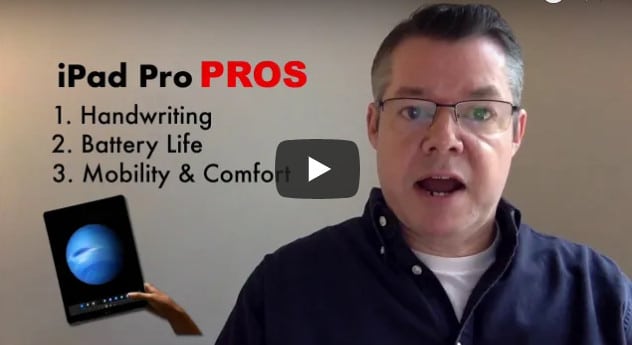Laptop users are loyal to their devices, but when portability is a priority, tablets can’t be beaten.
With so many strong tablet contenders on the market, narrowing down the options before making a purchase can seem overwhelming. This is especially true for shoppers who aren’t quite sure what features they’ll find most useful in a tablet. While there are dozens of capable models to choose from, there are two that stand out from the rest: the Apple iPad Pro and its worthy opponent, the Microsoft Surface Pro.
Apple’s iPad Pro and the Surface Pro have garnered their share of loyal users over recent years, and it’s easy to see why. Each boasts their own unique power and performance capabilities, but there are still plenty of differences between these two tablets.
Here are a few ways to distinguish which option of these two will work best for you.
Appearance
Apple has made big strides with the iPad Pro’s design. It manages to pack a 10.5-inch screen into a frame not much larger than the 9.7-inch Pro.
The Surface Pro takes this even further with a 12.3-inch display, though this is not without its caveats. The Surface Pro, with its larger screen, also weighs more than its iPad counterpart. The iPad Pro is slimmer than the Surface Pro, too, measuring just 0.24 inches thick.
Today’s tablet users aren’t settling for lackluster screen quality. Brilliant picture is preferred, and both contenders deliver this, though slightly differently. Apple’s 10.5 iPad Pro is packing a crisp, 2224 x 1668-pixel display, compared to the Surface Pro’s 2736 x 1824-pixel panel, which offers higher resolution.
Operating Systems
Operating systems, unsurprisingly, carry plenty of weight in the realm of tablets. The Surface Pro boasts a reliable, highly functional OS in Windows 10 Pro. With it comes a long list of benefits, including access to full versions of Win32 software, plus Flash, Java, apps and more.
Apple’s iOS is lacking in some areas Windows 10 is strong in, but not all hope is lost. The iPad’s got a new A10X Fusion chip intended to tackle a variety of intensive tasks, like 4K video editing and complex data spreadsheets. And with millions of apps to choose from on the Apple App store, you can be sure that security is top-notch. Apps on the App store require approval before becoming available to the masses, meaning picking up some malware as you download seems unlikely. Though, to be fair, Windows is striving for this same level of security, and may just replicate it with the newest Windows 10 S operating system.
Given that a tablets’ biggest strength lies in portability, battery life is of great importance to users, as it should be. The iPad, in many ways, sets the standard for battery life in tablets. In the showdown between the iPad and the Surface Pro, there is a big difference in battery life that shouldn’t be ignored. When put to the test, the iPad Pro allowed for 15 hours and 38 minutes of video streaming, while the Surface Pro tapped out at 8 hours and 25 minutes.
Multi-Tasking Capabilities
The ability to multi-task is another strong feature when it comes to tablets. A device with the power to do all you want it to, and then some, will ensure you get the most bang for your buck. In regard to workflow, you may find that iOS can’t handle all the tasks that Windows can. The iPad Pro has gotten a few upgrades, including the ability to drag and drop text, images and other files back and forth between apps. You’ll also find a customizable Dock ideal for easily accessing your most frequently used apps.
Windows’ updated capabilities include Timeline, a tool that allows users to jump back to a website, app or another file across platforms. Another app, named Windows Story Remix, can mix videos and photos with 3D objects to create unique themed videos.
Connectivity
Connectivity is an important factor to consider when shopping for laptops. The iPad Pro doesn’t offer much in terms of ports. It’s outfitted only with a lightning port, smart keyboard connector and headphone jack. This means you’ll need to purchase adapters and other add-ons to connect to external displays. The Surface Pro, on the other hand, contains a USB 3.0 port, a Mini DisplayPort, microSD card reader, Surface Connect port and Type Cover port. This renders the Surface Pro the clear winner in the battle for better connectivity.
Accessories
If you’re hoping to make the most of your tablet, you’d do well to pick up the right accessories. For the Surface Pro, this means Microsoft’s Type Cover, which is comparable to Apple’s Smart Keyboard. While both options will make for an easy typing experience, the Surface Pro has the advantage with its built-in hinge, which offers better positioning, as well as its built-in trackpad.
Both devices carry the option of a separately purchased stylus, and while the iPad’s $99 Pencil may navigate the screen more easily, the Surface’s pen has its own perks. It offers the option of different tips, so you can change them to suit your needs. Plus, it runs on an AAAA battery that can last up to a year. It also comes equipped with an eraser on top, as well as a programmable button.
If you’re hoping for a truly worthwhile tablet experience, you must do your due diligence. This means examining the many ways in which these two tablet heavy-hitters differ, and how each can impact your experience based on what you hope to use your tablet for.

 Mon-Fri 8 AM to 6 PM Mountain
Mon-Fri 8 AM to 6 PM Mountain 888-686-3025
888-686-3025




